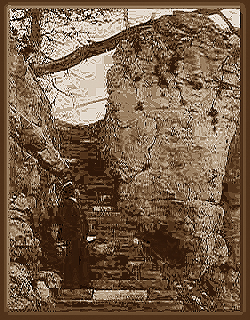 |
| NPS Photo | | Stone staircase built by the CCC. |
 |
Jewel Cave National Monument A local movement to set Jewel Cave aside for preservation culminated in the proclamation of the cave as a National Monument by President Theodore Roosevelt on February 7, 1908. The Michaud brothers eventually moved away and their family sold the claim to the government for about $750.
In 1928, a group of businessmen formed the Jewel Cave Corporation and provided tours to the public. This continued until 1939. The National Park Service began administering the monument in 1933 and park rangers from Wind Cave came to the monument in the summer.
The Civilian Conservation Corps established a camp at Jewel Cave in May 1935. Twenty-five men, with a budget of $1,500, accomplished several projects for the Park Service. A three-room cabin and comfort stations were built. Sewage and water connections were completed for the cabin and public campground. The cave entrance was altered to provide easier access, and a surface trail of approximately 800 feet was constructed, along with a new stone stairway. The Michaud’s original log building was removed at this time.
In 1939, a National Park Service Ranger was stationed at the monument and began conducting cave tours and providing visitor services. The cabin became home to the monument’s first permanent ranger in 1941. Except for a brief period of closure during World War II, NPS rangers staffed the cabin and cave tour operation. Then, in the late 1950s, significant discoveries were made within the cave, which lead to development of a new visitor center and cave tour route.
Recent History
At the beginning of 1959, approximately two miles of Jewel Cave had been discovered. Even though the cave was beautifully decorated with calcite spar crystals, the tour route was short, and some wondered whether this small cave was truly of national significance.
Then a geologist by the name of Dwight Deal enlisted the aid of two rock-climbing enthusiasts, Herb and Jan Conn, to help him explore within Jewel Cave. The Conns were particularly dedicated to exploring and mapping new passages, and by 1961, they had extended the known length of the cave to more than 15 miles. By then, the National Park Service had become interested in developing additional tour routes for the public to visit.
The initial discovery of the "Scenic Area" of the cave took place in 1961. But because the original boundaries of the National Monument dated back to a time when most of the cave was unknown, these new cave passages were actually outside of those boundaries, beneath U.S. Forest Service lands. In order to proceed with plans to develop a new tour route and visitor center, a land exchange with the Forest Service was accomplished in 1965, changing the monument boundaries. Construction of the present scenic area cave trail, the elevator shafts, one elevator, the visitor center, maintenance area, and parking lot began in 1966 and took nearly 5½ years to complete. The Scenic Cave Tour route and visitor center were first opened for touring on May 28, 1972.
Exploration of the cave continues, providing park managers with an increasing amount of information to use for future protection of this impressive resource.
| 





